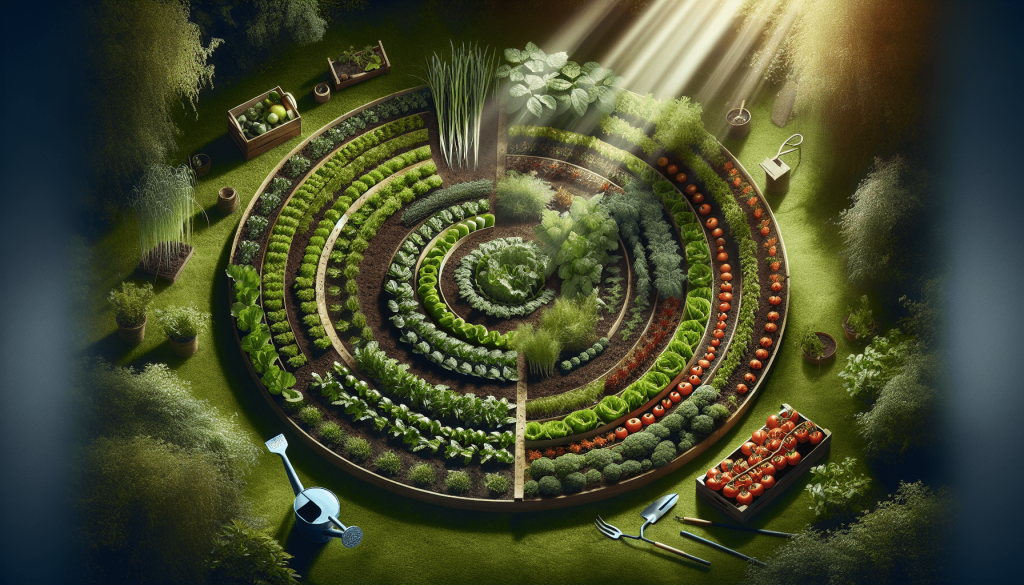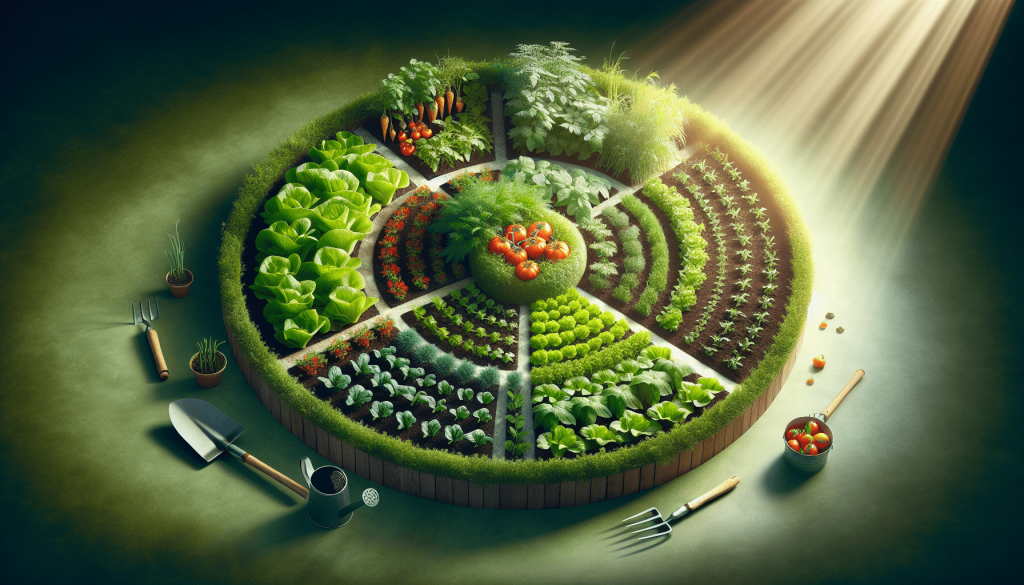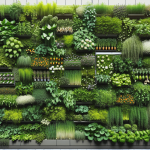This post may contain affiliate links. As an Amazon Associate, we may earn commissions from qualifying purchases.
Have you ever found yourself staring at your garden plot, wondering how to transform it into a flourishing paradise that sings with the rhythms of each season? Designing a garden that supports seasonal crop rotation can feel like solving a jigsaw puzzle, but the rewards are plentiful, from a bountiful harvest to healthier soil and happier plants.

Understanding the Basics of Seasonal Crop Rotation
Embracing seasonal crop rotation is like inviting harmony into your garden. It’s the process of growing different groups of plants in the same area but during different seasons. This strategy not only maximizes the use of nutrients in the soil but also helps in reducing pests and diseases. Think of it as a healthy diet for your garden soil, and just like your own diet, variety is key.
Why is Crop Rotation Important?
At its core, crop rotation is all about balance. Over time, planting the same crops repeatedly in the same space can drain the soil of essential nutrients, inviting pests to settle in like unwanted houseguests. Rotating crops prevents this, promoting biodiversity in the soil and reducing the reliance on chemical fertilizers and pesticides.
The Science Behind Crop Rotation
When you rotate crops, you’re rotating the nutritional demands those crops place on the soil. Some plants, like legumes, are kind enough to leave behind nutrients such as nitrogen, benefiting the crops that follow. Others, like heavy feeders such as tomatoes or corn, can strip the soil of its richness. Understanding these relationships helps you create a sustainable design for your garden.
Planning Your Garden Layout
Designing a garden isn’t just about where to place your favorite marigolds; it’s about crafting a well-thought-out plan that takes future seasons into account. Let’s break down how you can architect your garden masterpiece.
Mapping Your Garden Space
Grab a notebook, maybe a fancy pen if you’re feeling particularly artistic, and start sketching. Note where the sun casts its loving rays and where shadows might thwart your horticultural dreams. Pay attention to the slopes and the flatlands because water can really be picky about where it likes to sit. This detailed map will be your trusty guide through the seasons.
Grouping Plants by Families
In crop rotation, plants are categorized by ‘families’ — not because they gather for Thanksgiving, but because their nutrient and space needs are similar. Some common plant families include:
| Family | Examples |
|---|---|
| Legumes | Beans, peas |
| Solanaceae | Tomatoes, peppers, eggplants |
| Cucurbits | Cucumbers, squash, pumpkins |
| Brassicas | Cabbage, broccoli, kale |
| Root Vegetables | Carrots, beets, onions |
| Leafy Greens | Lettuce, spinach, chard |
By rotating these families, you ensure that no single nutrient is drained from the soil season after season, and each crop can thrive independently.
Season by Season: Designing for Change
Now that you’re armed with the basics of layout and plant families, it’s time to rethink your garden as a living, breathing thing that changes with the seasons.
Spring’s Fresh Start
Spring is like a morning cup of coffee for your garden, when everything perks up. This is the season for planting cool-season crops. Peas and leafy greens are eager to make their grand entrance. These crops are your soil-builders and nitrogen-fixers, ready to pave the way for summer’s heat-lovers.
Summer’s Abundance
Ah, summer—the time when your garden boasts a riot of colors and smells. Summer is home to juicy tomatoes, sprawling squash, and vibrant peppers. These sun-seeking plants are heavy feeders, basking in the warmth and richness provided by the previous crop’s generosity.
Autumn’s Bounty and Transition
As the days shorten, it’s time to think about cool-season crops again, but now you’re looking at root vegetables and brassicas. These not only provide nutrient-dense produce but also prepare your soil for its winter nap, as their remnants and leaves can be turned back into the soil for added nutrients.
Winter’s Rest and Reflection
While winter is a quiet season for growing, it’s a time for you and your soil to recharge. Cover crops, such as rye or clover, work as nature’s protective blanket, preventing erosion and enriching the soil with organic matter. Use this time to reflect, plan, and prepare for the cycle to begin anew.
Tips for Successful Crop Rotation
Now that you’ve set the stage, let’s bring in the supporting acts of gardening success.
Keep Detailed Records
A garden journal is like a secret decoder ring for crop rotation chaos. Write down what you plant and where, and capture lessons learned each season. This historical record will help you avoid repeating mistakes and ensure you’re rotating correctly.
Embrace Diversity
Diversity in your garden isn’t just for show; it’s a strategic masterstroke. By planting a mix of crops from different families, you create a stronger ecosystem with natural pest regulators and soil enhancers. Your garden should look less like a model wearing all black and more like a vibrant parade.
Pay Attention to Timing
Crop rotation is also about timing. Stagger your planting and harvesting to maximize your garden’s output without exhausting it. Use quick-growing crops to fill gaps and support the health of your soil. Think of it as orchestrating a symphony; each note has its perfect moment to shine.

Overcoming Common Challenges
Like any hero’s journey, designing a garden faces challenges that require cunning tactics and gentle persistence.
Dealing with Limited Space
If your gardening space is more modest than you’d like, vertical gardening and container planting can be your best friends. Use trellises for cucumbers or beans, and try tiered containers for lettuce and herbs to expand your planting area without needing acreage.
Battling Pests and Diseases
A diverse garden can naturally fend off some indicators of betrayal, but sometimes the pests are as tenacious as your toddler at bedtime. Use companion planting to form alliances; marigolds, for instance, can help keep nematodes at bay in your tomato bed.
Adapting to Climate Change
The unpredictability of weather is like a plot twist in a sitcom—not always welcome. Keep a keen eye on long-term climate patterns and adjust your crop rotation plan accordingly. Choose crop varieties known for resilience and be ready to adapt your practices to suit shifting conditions.
Tools and Resources for a Well-Rotated Garden
Your trusty shovel and watering can are essential, yet there’s a world of tools and resources that can elevate your crop rotation game.
Digital Tools for Mapping and Planning
Garden planning apps can turn your paper sketches into digital masterpieces. Apps like Garden Planner and Plan-a-Garden allow you to visualize crop rotations in pixels, offering reminders and data insights that streamline your process.
Books and Publications
The wisdom of gardening sages is waiting to be discovered in books like “The Vegetable Gardener’s Guide to Permaculture” by Christopher Shein and “Crop Rotation and Soil Protection” by DK Publishing. These volumes are filled with tips, techniques, and luscious photography to inspire your rotations.
Local Gardening Communities
Seek out fellow gardeners in your community or online forums to swap stories, share surplus crops, and gain insights into region-specific challenges. Sometimes, an afternoon chat over coffee with someone who shares your passion is all it takes to spark new ideas and solutions.
Reflecting on Your Gardening Journey
As you stand back and take in your well-organized plot, imagine not just the next harvest but the many that will follow. Each decision, be it the choice of seed or the slope of a garden bed, is part of a greater tapestry of growth.
Gardening teaches patience through its rhythms. It’s about learning to observe and partner with nature rather than trying to shoehorn your will upon it. As you embark on your renewed gardening journey, remember that the goal isn’t perfection but rather a continued adventure of trial, learning, and most importantly, enjoyment.
Designing a garden that supports seasonal crop rotation isn’t just about creating a rotating checklist of chores; it’s about nurturing a living system. In its cycles and seasons, we are gifted with a sense of continuity and wonder. Doesn’t that make the labor more of a joy and less of a chore? So take a deep breath, pick up that trowel, and start plotting your course around the garden galaxies with renewed vigor.
Now, armed with knowledge and a touch of whimsy, you’re prepared to cultivate a garden that not only delights the senses but also cherishes the earth beneath it.








